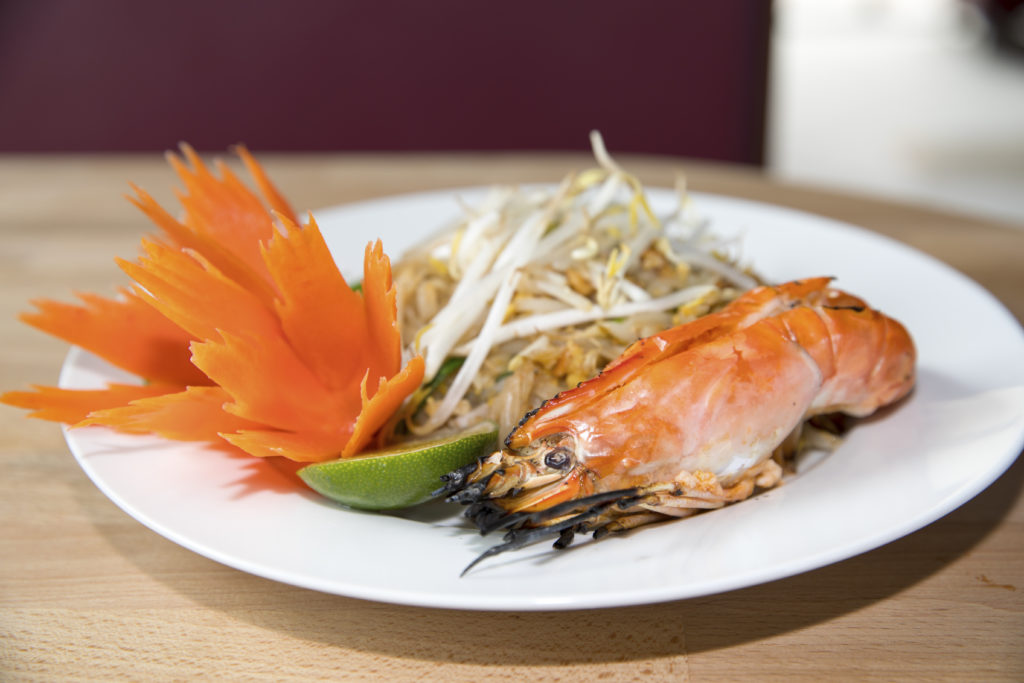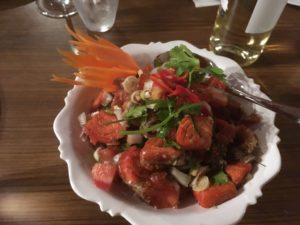
You don’t have to be a social historian to know one thing about class societies: they always develop distinct differences between the ruler and the ruled. Think of Jeeves and Wooster, Downton Abbey, anything written by Jane Austen that was ever translated to visual media. The cut of the clothes is the obvious clue, but even when someone is off camera you know their class because their accent tells you.
That extends to food, and it’s not just that the tables of aristocrats would have more choices served on more elaborate dinnerware. Using expensive spices and ingredients was a way to show your wealth in Europe, and in the days when cloves and pepper were shipped halfway around the world their appearance showed the host’s importance.
The lavish use of spices wouldn’t be very impressive to people in Thailand because seasonings are in every kitchen, but there is a royal style of dining nevertheless. The goal is elegance of presentation and subtlety, and many items are actually more mild than common street foods.
This style of dining is featured at Redondo’s new restaurant Subhannahong, the restaurant in the upstairs space that used to be Ocean Tava. The name means “royal barge” and refers to the gilded and elaborately decorated boat that ferries the King to ceremonies in the capital. The décor at the restaurant doesn’t follow through on the name and is unusually subdued, the dark walls sparsely adorned with low key art, but a boat paddle on one wall does reference the theme.
The menu you are given on arrival has no descriptions, and you should ask for a take-out menu because that is more informative and has some photos. We relied much more on a conversation with the owner. Since the restaurant wasn’t busy that evening he had time to describe items, and we trusted his guidance. He is fairly fluent in English and honestly let us know when we were about to over-order.

The first item to arrive used two non-Thai items: salmon and apples. Apples are an expensive imported item in Thailand, and there is no fish anything like salmon because the distinctive oiliness of that fish develops in cold waters. The richness and flavor works great with apples, green onion, and a vinegary, spicy sauce that left our lips tingling. I had expected this item to be relatively mild, but it came out quite zippy.
So did the larb with bacon, another modern anomaly because smoked meats are alien to Thailand, which lacks woods that lend a pleasant flavor. When I asked the owner about this, he replied matter-of-factly, “Everybody likes larb, and everybody likes bacon, so we put them together.” It’s hard to argue with logic like that. The smoky pork did indeed go well with the sautéed ground chicken with toasted rice powder in a spicy, vinegary marinade, though I would have preferred the bacon be cut a bit smaller so it mixed more evenly in the dish.
As a respite from the spicy items we had Tod Mun Goong, the fried fishcakes that are misleadingly described as “fried shrimp paste custard.” It’s really a mix of shrimp, fish, and microscopic amounts of vegetable that are dipped in egg batter before frying, and they’re simple but satisfying.
For main courses we tried their “200 Years Pad Thai,” squid stuffed with pork in Panang curry, and a soup made with pork-stuffed cucumber. The Pad Thai from a two century old recipe looked very simple: a mix of rice noodles, chopped peanut, and a bit of scallion and napa cabbage topped with bean sprouts, with a huge prawn and some raw scallion on the side. The flavor was mild and slightly sweeter than usual, just a bit different from what you might find elsewhere.
Panang curry sauce shows the influence of Muslim traders from Malaysia and is a bit more like an Indian red curry than most Thai items. I haven’t seen it paired with stuffed squid before, but it’s a great idea. The large squid body was filled with a mix of lightly seasoned pork and shrimp and was fork-tender, something that is not easy to achieve with squid.
The big surprise of the meal, though was the pork-stuffed cucumber in soup. I don’t usually think of cooking cucumber at all, but it made a superb and refreshing soup that was an antidote to the spiciness of other dishes. This was a side of Thai cuisine I’ve only rarely experienced here or in
Thailand, one that brings out the flavor of an ingredient and lets it shine.
Subhannahong doesn’t have a wine and beer license yet, so we brought bottles of Portuguese Vinho Verde, an Albarino, and a Verdelho to sample. All were low-alcohol with a little flowery sweetness, which works well with cuisines with spice and vinegar, and the Portuguese was the winner by a nose.
So if nobody had told me the food at Subhannahong was a separate style, would I have known? Probably not. I might have noticed the seasonings were a little different, a general emphasis on light and sweet flavors, but I might have chalked it up to the chef’s personal preferences or family recipes. This isn’t a culinary difference to be compared with overhearing a conversation between a Cockney and the Queen. I will be back, though, to try more dishes and see if I can discern the unique elements for myself.
Subhannahong is at 1212 South PCH in Redondo. Open daily at 11 a.m. close 9:30 p.m. Mon-Sat, 9 p.m. Sun. Parking in lot (entry from Avenue E), wheelchair access good, patio dining, no corkage fee. Menu at subhannahong.com, phone 310-316-3033. ER









